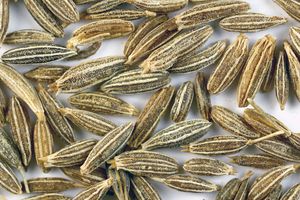Note: This is a project under development. The articles on this wiki are just being initiated and broadly incomplete. You can Help creating new pages.
Cuminum cyminum - Ajaji, Cumin seed
Cuminum cyminum is a flowering plant in the family Apiaceae, native from the east Mediterranean to South Asia.Its seeds (each one contained within a fruit, which is dried) are used in the cuisines of many different cultures, in both whole and ground form. It also has many uses as a Traditional medicine plan.
Contents
Uses
Improving breast milk, Uterine fibroid, indigestion, Diarrhoea, Skin diseases, Fever, Hyper-acidity, {{Uses|Insomnia}, piles, Parasitic worms, Leucorrhoea, Spider sting.
Parts Used
Chemical Composition
Cumin seeds are antimicrobial, anti-diabetic, antiepileptic, antifertility, anticancer, antioxidant and immunomodulatory.[1]
Common names
| Language | Common name |
|---|---|
| Kannada | Jirage, Bilejiregeu |
| Hindi | Jira, Safed jira |
| Malayalam | Jeerakam |
| Tamil | Sheeragam, Chirakam, Jeerakam |
| Telugu | Jilakarra, Tella Jilakarra |
| Marathi | NA |
| Gujarathi | NA |
| Punjabi | NA |
| Kashmiri | NA |
| Sanskrit | Ajaji |
| English | Cumin seed, Cumin |
Habit
Identification
Leaf
| Kind | Shape | Feature |
|---|---|---|
| Simple | petiole bonded | hairless, elongated and devided.its foliage is devided into filiform segment |
Flower
| Type | Size | Color and composition | Stamen | More information |
|---|---|---|---|---|
| Unisexual | White, Pink | The flowers are like tiny hermaphrodite and each umbelmay cotain between 3 or 5 radios. | {{{5}}} |
Fruit
| Type | Size | Mass | Appearance | Seeds | More information |
|---|---|---|---|---|---|
| ovel, narrow | 5-6mm long | the fruites of the plnat is classified among the nuts and it is daichene | they are ash brown and pubscent | single seed |
Other features
List of Ayurvedic medicine in which the herb is used
- Vishatinduka Taila as root juice extract
Where to get the saplings
Mode of Propagation
How to plant/cultivate
Start seeds inside 6 to 8 weeks before average last frost. Start outside 1 to 2 weeks after average last frost and when the temperatures are warm. Plant a group of 4 seeds at a depth of ¼ inch every 4 to 8 inches. When seedlings are 2 inches tall, thin to 1 plant every 4 to 8 inches. Seed should germinate in 7 to 14 days[3]
Commonly seen growing in areas
Photo Gallery
References
External Links
- Artocarpus hirsutus on ENVIS Centre on Conservation of Medicinal Plants
- Artocarpus hirsutus on India Biodiversity Portal
- Artocarpus: A review of its traditional uses, phytochemistry and pharmacology
- Artocarpus: A review of its phytochemistry and pharmacology
- Pharmacognostical studies on the bark of Artocarpus hirsutus Lam
- Ayurvedic Herbs known to be helpful to treat Improving breast milk
- Ayurvedic Herbs known to be helpful to treat Uterine fibroid
- Ayurvedic Herbs known to be helpful to treat indigestion
- Ayurvedic Herbs known to be helpful to treat Diarrhoea
- Ayurvedic Herbs known to be helpful to treat Skin diseases
- Ayurvedic Herbs known to be helpful to treat Fever
- Ayurvedic Herbs known to be helpful to treat Hyper-acidity
- Ayurvedic Herbs known to be helpful to treat piles
- Ayurvedic Herbs known to be helpful to treat Parasitic worms
- Ayurvedic Herbs known to be helpful to treat Leucorrhoea
- Ayurvedic Herbs known to be helpful to treat Spider sting
- Herbs with seeds used in medicine
- Herbs with fruits used in medicine
- Herbs with common name in Kannada
- Herbs with common name in Hindi
- Herbs with common name in Malayalam
- Herbs with common name in Tamil
- Herbs with common name in Telugu
- Herbs with common name in Sanskrit
- Herbs with common name in English
- Habit - Shrub
- Index of Plants which can be propagated by Seeds
- Herbs that are commonly seen in the region of Manitoba
- Herbs that are commonly seen in the region of Norway
- Herbs that are commonly seen in the region of Rainyzones
- Herbs


